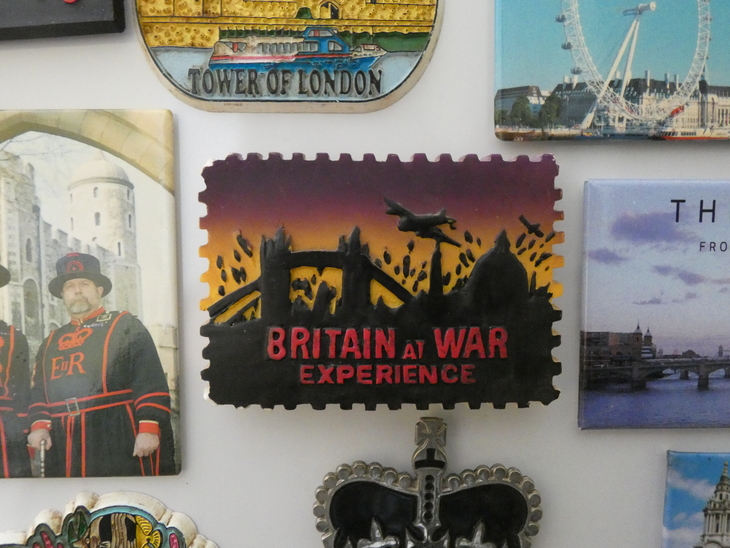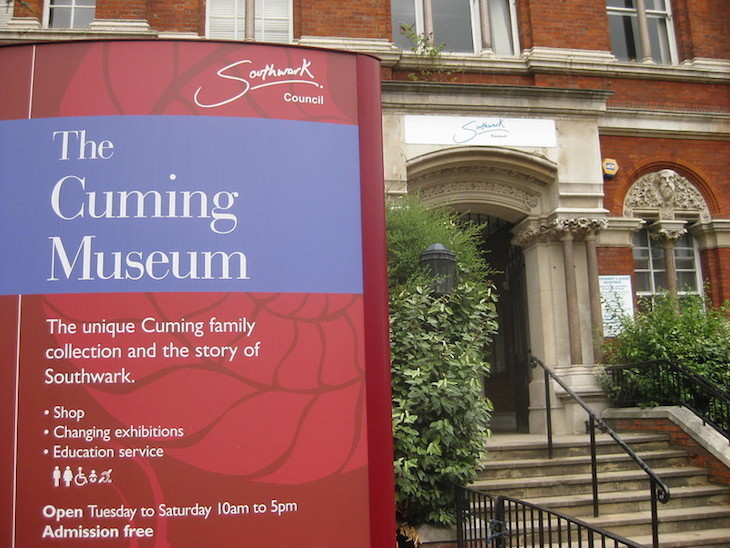
London's absolutely chock-full of museums, with new ones opening all the time. But what about those which close down?
The Londonist team put their nostalgic heads together, to create this list of lost museums. There are several we remember visiting as children, which no longer exist — perhaps you visited some of these too?
Bramah Tea & Coffee Museum (1992-2008)

Despite closing in 2008 following the death of its founder, signs to the Bramah Tea & Coffee Museum could still be seen in the area around Hay's Galleria well into the 2010s. It initially opened in Butler's Wharf in Shad Thames in 1992, before moving to Southwark Street, and was the work of Edward Bramah, tea expert and founder of the Bramah Tea & Coffee Company.
It told the story of tea in this country, from its introduction by Catherine of Braganza, via Bramah's own collection of teapots, to historic labels from brands such as Horniman's and Lipton's.
Modern equivalent: Twinings' titchy-but-interesting shop museum, Bermondsey's biscuit museum, or further afield, Kent's Teapot Island.
The London Toy & Model Museum, Bayswater (1982-1999?)
You know what London's severely lacking these days? Affordable housing A ride-on rooftop train. Londonist Editor Will Noble has a fond childhood memory of riding the rooftop train at the London Toy and Model Museum, which was located at Craven Hill near Paddington between 1982 and 1999.
According to an archived version of the museum's website, it housed more than 7,000 toys and models, spread over two adjoining Victorian townhouses (which have since been reverted to residential use). Various methods of transport, it seems, ruled, with ships, boats, aircraft, airships, trains, cars, motorbikes and buses all mentioned on the list of exhibits, though games, dolls and penny arcade machines also featured. A Paddington Bear given by Shirley Clarkson to her young son Jeremy (yes, that Jeremy Clarkson) was among the most celebrated items.
Oh, and that train? A miniature steam train, which ran on the rooftop, weather permitting. Sound too good to be true? Thankfully, some kind soul had the foresight to video it, back in 1989 (see above). Here, it chugs across a tiny bridge of questionable structural integrity over an unidentified body of water, before circling a picnic area and pulling into a rather professional looking station.
Modern equivalent: Pollock's Toy Museum in Fitzrovia, or Brighton Toy & Model Museum, the House on the Hill Toy Museum in Essex, or the Young V&A (previously the Museum of Childhood — due to reopen in 2023).
The Newsroom, 60 Farringdon Road (2002-2008)

Another one from the Londonist team's personal memory bank is The Newsroom — though until now, we didn't know its proper name, remembering it as a rather modern newspaper museum we visited in our teenage years.
The Newsroom was an archive and visitor centre of The Guardian and Observer newspapers, located opposite the company's previous office in Farringdon before they moved to King's Cross in 2008. It was founded in 2002 as a way to record the newspapers' own history, and featured notebooks, sketches and photos donated by Guardian journalists. It also housed temporary exhibitions including the Here is New York photographic display produced in the wake of 9/11.
Though The Newsroom didn't make the move to King's Cross in its previous format, much of the back catalogue is now available on The Guardian and Observer Digital Archive.
Modern equivalent: The British Library has a wealth of newspaper archives.
The Blitz/Britain at War Experience (closed 2013)

Another trip down memory lane for us, one that recalled sitting in a mock Anderson shelter while Blitz-style bombings were simulated overhead, making excellent use of light and sound effects. A bizarre childhood experience, and one we would have convinced ourselves we'd imagined if we didn't still have the souvenir fridge magnet to prove it.

The Britain at War Experience — also known as the Blitz Experience — was located at 64-66 Tooley Street, near London Bridge station. It's possible that the redevelopment of the station was the reason for the museum's closure, though we can't be sure. Its website survives, declaring the venue's intention to give people an idea of what it was like to live in Britain in the second world war. Documents, photos and video footage explored several aspects, from shopping during rationing, to evacuated children, to the theatres and clubs where GIs were entertained in London.
Modern equivalent: Imperial War Museum, and Docklands at War at Museum of London Docklands.
Prince Henry's Room (1975-1985?)

It's not every day you get invited into a prince's boudoir — a King's Wardrobe is a different matter — but you used to be able to visit Prince Henry's Room. We've covered the history of the first floor Fleet Street space before, but what of its use as a museum?
Its first public airing was as Mrs Salmon's Waxworks, which opened at this location in 1795, one of several such waxworks museums at the time. It's thought the waxworks stayed here until about 1816, but that wasn't the end of public exhibitions in Prince Henry's Room.
In 1975, the Samuel Pepys Society opened an exhibition in the room, dedicated to the famous diarist. He was born around the corner, and known to visit this particular building during its time as the Fountain Inn. There is little information available about the Pepys museum, except that it's thought to have closed about a decade later. The building belongs to the City of London and has been open to the public since the Pepys museum — here's an account of one such visit — but it closed, we think, in around 2006.
Modern equivalent: Madame Tussauds for your waxwork needs.
The Cuming Museum (2006-2013)

The Cuming Museum began life as the personal collection of Richard and Henry Cuming, mainly focusing on fossils, coins and medals. By 2006, the collection was kept at Walworth Town Hall, and had expanded to include objects depicting the local history of Southwark. In 2013, the building went up in flames, and the Cuming Museum was no more. Thankfully, no-one was hurt, and much of the Cuming collection was saved — though some objects were later stolen from the fire-ravaged building.
In the intervening years, pop-up versions of the museum have appeared at certain events, such as Bermondsey Carnival, giving the public a chance to see some of the objects again. These days, a slimline version of the museum's collection can be seen in the new Southwark Heritage Centre and Walworth Library, though there isn't room to display the full collection. Some of it can be explored online instead.
Theatre Museum, Covent Garden (1987-2007)

It seems obvious, when you think about it, that Covent Garden should have a theatre museum, but it doesn't... anymore. Previously, the Theatre Museum — also known as the National Museum of the Performing Arts — could be found next door to the Royal Opera House, an outpost of the V&A which displayed documents, costumes, designs, manuscripts, books, video recordings and more relating to the business of the theatre, from the 16th century onwards.
Ultimately, a lack of funds caused the curtain to come down on the museum, and its collections were transferred to the V&A's main museum in South Kensington, where a new theatre gallery was created. However, at time of writing, there are suggestions that staffing cuts due to financial difficulties brought about by the pandemic may reduce the number of specialist staff working in the Performance department at the V&A.
The Planetarium, Baker Street (1958-2006)

Perhaps London's most famous 'lost' museum is the Planetarium, formerly resident in the Baker Street domed edifice which now houses Madame Tussauds and showcases stars of a completely different kind.
Built on the former site of a cinema which was destroyed in the Blitz, it opened in 1958, offering public presentations about the view of the night sky, as seen from Earth. In its later years, more modern technology including lasers and 3D imaging equipment was used to immerse audiences in space, but that didn't save the attraction, and its closure was announced in 2006.
Modern equivalent: Royal Observatory Greenwich is home to the Peter Harrison Planetarium, London's only public planetarium. Read our guide to stargazing in London for other places to see the cosmos.
Firepower Royal Artillery Museum, Woolwich (1820-2016)

One of the world's oldest military museums used to be located in Woolwich, having existed in the area in some form since the 1820s. Firepower at the Royal Arsenal opened in 2001, displaying all manner of military artillery equipment including guns, carriages, cannons and the like. But it only lasted 15 years — a lack of visitors out in the wilds of south-east London was blamed. Its closure was announced in 2014, and happened in July 2016. There are plans for a new museum housing the collection to be established near Salisbury in Wiltshire — close to the regiment's home — but this doesn't seem to have come to fruition yet.
Modern equivalent: The National Army Museum, or the Household Cavalry Museum.
Ripley's Believe It Or Not (2008-2017)

We could not believe it when Piccadilly Circus stalwart Ripley's Believe It Or Not shuttered its doors, quietly and without fanfare, in October 2017. The collection of oddities had been luring in tourists since 2008, treating them to sights such as a portrait of JFK made from dead butterflies. While some of its exhibits were remarkable, it was best known for its opening hours — until midnight some nights, and on Christmas Day every year.
It was soon replaced by the controversial Body Worlds attraction, Gunther von Hagens' travelling exhibit of preserved human corpses. But that too has shut up shop, having not reopened since lockdown forced its closure.
There are plenty more London museums which are now defunct. But do you have any fond/vivid memories of them? Share in the comments below. If lost museums — not just in London — interest you, PhD candidate Mark Liebenrood's website is a fascinating resource.




